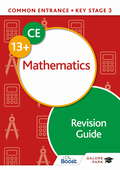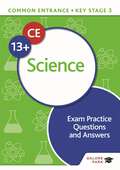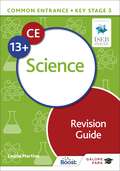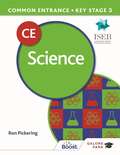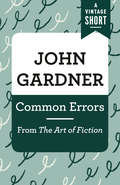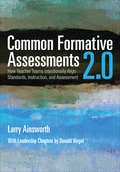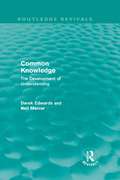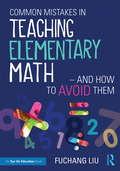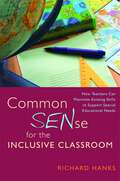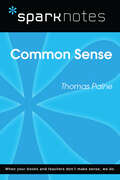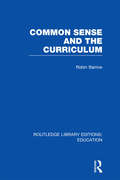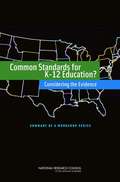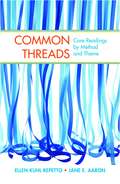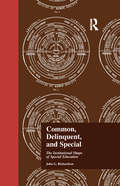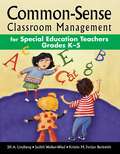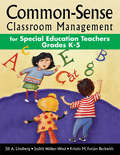- Table View
- List View
Common Entrance 13+ Mathematics Revision Guide
by David E Hanson Stephen FroggattExam board: ISEB Level: 13+ CE and KS3 Subject: Maths First exams: November 2022This comprehensive, ISEB-endorsed guide for Mathematics focuses on consolidating knowledge and covering all the skills needed to meet the requirements of the ISEB CE 13+ exam.· Extensive coverage of all Core and Additional topics: number, algebra, measurement, geometry, probability and statistics.· Additional chapters: basic skills, mental strategies, problem solving skills, puzzles and projects.· Improve knowledge and skills: practise all types of questions from mental arithmetic to thought-provoking puzzles as well as a glossary of mathematical terms.· Prepare for the exam: 'make sure you know' summary per chapter, exam-style questions, 'test yourself' questions and guidance to support thinking, working out and planning a well-structured answer.Continue your revision with Common Entrance 13+ Mathematics Exam Practice Questions and Answers (ISBN: 9781398326491).
Common Entrance 13+ Science Exam Practice Questions and Answers
by Ron PickeringExam board: ISEB Level: 13+ CE and KS3 Subject: Science First exams: November 2022Improve exam technique and build confidence to ensure success in the CE 13+ Science exams with these practice questions in the style of the ISEB exams.· Practice for all sections of the exam: Biology, Chemistry and Physics for Foundation and Level 2 papers.· Guidance on the exam: how to approach different types of questions and understand what is required from all possible questions.· Identify gaps in knowledge: answers are included to help pinpoint areas for improvement.Pair with Common Entrance 13+ Science Revision Guide for comprehensive exam preparation (ISBN: 9781398340923).
Common Entrance 13+ Science Exam Practice Questions and Answers
by Ron PickeringExam board: ISEB Level: 13+ CE and KS3 Subject: Science First exams: November 2022Improve exam technique and build confidence to ensure success in the CE 13+ Science exams with these practice questions in the style of the ISEB exams.· Practice for all sections of the exam: Biology, Chemistry and Physics for Foundation and Level 2 papers.· Guidance on the exam: how to approach different types of questions and understand what is required from all possible questions.· Identify gaps in knowledge: answers are included to help pinpoint areas for improvement.Pair with Common Entrance 13+ Science Revision Guide for comprehensive exam preparation (ISBN: 9781398340923).
Common Entrance 13+ Science Revision Guide
by Louise MartineExam board: ISEB Level: 13+ CE and KS3 Subject: Science First exams: November 2022This comprehensive, ISEB-endorsed revision guide for Science focuses on consolidating knowledge and covering all the skills needed to meet the requirements of the ISEB CE 13+ exam.· Recap preliminary knowledge: summaries and reminders from the ISEB 11+ science specification.· Covers learning outcomes: Know (knowledge to be learned and recalled), Understand (application of knowledge to familiar and new concepts) and Recognise (awareness of how the knowledge applies to science and society), as well as recommended practical activities.· Develop critical thinking: 'Ask yourself' questions appear throughout to prompt recognition and development of scientific attitudes using the knowledge and understanding gained. · Prepare for the exam: exam-style questions included at the end of each chapter with three 'Test yourself' sections for Biology, Chemistry and Physics with answers provided for all questions.Continue your revision with Common Entrance 13+ Science Exam Practice Questions and Answers (ISBN: 9781398326507).
Common Entrance 13+ Science Revision Guide
by Louise MartineExam board: ISEB Level: 13+ CE and KS3 Subject: Science First exams: November 2022This comprehensive, ISEB-endorsed revision guide for Science focuses on consolidating knowledge and covering all the skills needed to meet the requirements of the ISEB CE 13+ exam.· Recap preliminary knowledge: summaries and reminders from the ISEB 11+ science specification.· Covers learning outcomes: Know (knowledge to be learned and recalled), Understand (application of knowledge to familiar and new concepts) and Recognise (awareness of how the knowledge applies to science and society), as well as recommended practical activities.· Develop critical thinking: 'Ask yourself' questions appear throughout to prompt recognition and development of scientific attitudes using the knowledge and understanding gained. · Prepare for the exam: exam-style questions included at the end of each chapter with three 'Test yourself' sections for Biology, Chemistry and Physics with answers provided for all questions.Continue your revision with Common Entrance 13+ Science Exam Practice Questions and Answers (ISBN: 9781398326507).
Common Entrance 13+ Science for ISEB CE and KS3
by Ron PickeringExam board: ISEB Level: 13+ CE and KS3 Subject: Science First teaching: September 2021 First exams: November 2022With more than 30 years' experience teaching Science, Ron Pickering brings his renowned expertise and attention to detail to the new Science series for Common Entrance and Key Stage 3. Trust Ron to guide you and your pupils through the new ISEB 13+ Science specification and motivate them to excel as they think and work as scientists.- Cover all the content for Biology, Chemistry and Physics in one book: More convenient and cost-effective for teachers and pupils.- Expand your pupils' understanding of the role of key scientists in history: Information on the contributions made to our scientific understanding by scientists of the past including Dmitri Mendeleev, Mary Anning and Sir Isaac Newton.- Encourage your pupils to see Science in a wider context: Cross-curricular links with Mathematics, Geography, Environmental Science and PSHE.- Develop key scientific skills for the exams and beyond: Throughout the book there are many investigations that will help pupils to explore the depth of their scientific understanding, including how to record observations, analyse and present data, and how to interpret results and draw conclusions.- Improve exam technique: End of topic questions reflect the style of the new examination papers.Accompanying answers available in a paid-for PDF download at galorepark.co.uk (ISBN: 9781398321694).
Common Entrance 13+ Science for ISEB CE and KS3
by Ron PickeringExam board: ISEB Level: 13+ CE and KS3 Subject: Science First teaching: September 2021 First exams: November 2022With more than 30 years' experience teaching Science, Ron Pickering brings his renowned expertise and attention to detail to the Science series for Common Entrance and Key Stage 3. Trust Ron to guide you and your pupils through the ISEB CE 13+ Science specification and motivate them to excel as they think and work as scientists.· Cover all the content for Biology, Chemistry and Physics in one book: More convenient and cost-effective for teachers and pupils.· Expand your pupils' understanding of the role of key scientists in history: Information on the contributions made to our scientific understanding by scientists of the past including Dmitri Mendeléev, Mary Anning, Sir Isaac Newton and Mary Seacole.· Encourage your pupils to see Science in a wider context: Cross-curricular links with Mathematics, Geography, Environmental Science and PSHE.· Develop key scientific skills for the exams and beyond: Investigations help pupils to explore the depth of their scientific understanding, including how to record observations, analyse and present data, and how to interpret results and draw conclusions.· Improve exam technique: End-of-topic questions reflect the style of the ISEB CE 13+ examination papers.Accompanying answers available in a paid-for PDF download at galorepark.co.uk (ISBN: 9781398321694).
Common Errors: From The Art of Fiction (A Vintage Short)
by John GardnerA Vintage Shorts selection.In this chapter from his classic instructive handbook, The Art of Fiction, John Gardner illustrates the principles and techniques of good writing. Poor diction, confusing clauses, undue sentimentality and mannerism—these are pitfalls that plague experienced writers as well as those new to the craft. Exemplified with detailed excerpts from classic works of literature, Gardner explores how to achieve vivid, sensuous prose and how to avoid clumsy writing. All those who aspire to learn how to master the craft of fiction will be wise to begin with Gardner’s invaluable advice.An ebook short.
Common Formative Assessments 2.0: How Teacher Teams Intentionally Align Standards, Instruction, and Assessment
by Donald J. Viegut Larry B. AinsworthAssessments that improve the speed and quality of learning—fully updated for teacher teams! In this expanded, all-new edition, author Larry Ainsworth provides a system of intentionally aligned components (standards, instruction, assessments, and data analysis) that all work together to improve student learning. Readers will learn to: Build the “highway” to aligned assessments Decide the learning intentions and student success criteria for a unit of study Evaluate and revise assessment questions for quality Plan the learning progressions for students to attain the learning intentions Create quick progress checks to coincide with the learning progressions Use assessment results as feedback to adjust instruction and student learning strategies Upgrade your CFAs using CFA 2.0! CFA 2.0 is so much more than assessment design. It shows teachers how they can intentionally align standards, instruction, assessment, and data analysis in every unit of study.
Common Formative Assessments 2.0: How Teacher Teams Intentionally Align Standards, Instruction, and Assessment
by Donald J. Viegut Larry B. AinsworthAssessments that improve the speed and quality of learning—fully updated for teacher teams! In this expanded, all-new edition, author Larry Ainsworth provides a system of intentionally aligned components (standards, instruction, assessments, and data analysis) that all work together to improve student learning. Readers will learn to: Build the “highway” to aligned assessments Decide the learning intentions and student success criteria for a unit of study Evaluate and revise assessment questions for quality Plan the learning progressions for students to attain the learning intentions Create quick progress checks to coincide with the learning progressions Use assessment results as feedback to adjust instruction and student learning strategies Upgrade your CFAs using CFA 2.0! CFA 2.0 is so much more than assessment design. It shows teachers how they can intentionally align standards, instruction, assessment, and data analysis in every unit of study.
Common Ground: Second Language Acquisition Theory Goes to the Classroom
by Florencia G. Henshaw Maris D. Hawkins&“Common Ground is accessible to teachers at all levels yet firmly rooted in current questions of second language acquisition (SLA). One of its primary strengths is the authors themselves, both of whom are accomplished language teachers who understand the challenges and opportunities in communication-focused language teaching. Their experience, expertise, insight, and enthusiasm for language teaching translate into a book that is refreshingly practical for teachers, especially teachers who are striving to break from traditional drills commonly presented in textbooks. I hope this book finds its way into the hands of every language teacher who is looking for concrete examples of how SLA principles meet the realities of the classroom."—Stacey Margarita Johnson, Vanderbilt University
Common Knowledge: The Development of Understanding in the Classroom (Routledge Revivals)
by Neil Mercer Derek EdwardsFirst published in 1987, Common Knowledge offers a radical departure from the traditionally individualistic psychologies which have underpinned modern approaches to educational theory and practice. The authors present a study of education as the creation of ‘common knowledge’ or shared understanding between teacher and pupils. They show the presenting, receiving, sharing, controlling, negotiating, understanding and misunderstanding of knowledge in the classroom to be an intrinsically social communicative process which can be revealed only through close analysis of joint activity and classroom talk. Basing this analysis on a detailed examination of video-recorded school lessons with groups of 8 to 10-year-olds, they show how classroom communications take place against a background of implicit under-standing, some of which is never made explicit to pupils, while there develops during the lessons a context of assumed common knowledge about what has been said, done, or understood. This wide-ranging study makes an important contribution to the current debate about both teaching methods and the structure of education. It is essential reading for educationalists and developmental psychologists and has a clear practical relevance to teachers and teacher trainers.
Common Mistakes in Teaching Elementary Math—And How to Avoid Them: And How To Avoid Them
by Fuchang LiuLearn the most effective ways to teach elementary math, no matter how much experience you have with the subject. In this book, Fuchang Liu takes you through many common mistakes in math instruction and explains the misunderstandings behind them. He points out practices that should be avoided, helping you to adjust your lessons so that all students can achieve success. You’ll discover how to… - Increase your confidence with core math principles and reasoning - Set your students on the path toward eventually developing more complex math skills - Improve student achievement by approaching problems in logical yet creative ways - Overcome common challenges faced by students and teachers - Teach problem solving for different learning styles Every chapter reconsiders well-established ways of teaching all areas of elementary math, from addition and subtraction to statistics and graphs. Helpful examples and tips are scattered throughout the book, offering revisions to the way these topics are often presented in the classroom. Also included are group study ideas for principals and instructional coaches so your school or district can work on the book together. With this practical guide, you’ll be ready to help students truly develop their math understanding.
Common Places: Integrated Reading & Writing (Third Custom Edition)
by HoeffnerCommon Places teaches students to read from a writer's point of view by considering the choices writers make when presenting their content. It also encourages students to write from a reader's point of view as they face the same choices with their own writing. Students immediately and continually emulate recursive reading and writing processes as they work through the text.
Common SENse for the Inclusive Classroom
by Richard HanksThis book condenses everything the mainstream teacher needs to know about Special Educational Needs into one short volume, allowing them to pick and choose teaching methods that suit them and each individual student. Following a revolutionary 'a la carte' concept, the book acts first and foremost as a teaching menu, offering a variety of options that teachers can use as they see fit. Written in a jargon-free, accessible style, the author gets to the heart of issues associated with teaching mixed ability classes, offering more flexible alternatives to traditional teaching strategies and suggesting helpful approaches that really work. Maintaining that teachers are usually far more capable of handling situations than they believe themselves to be, the book allows them to choose methods that suit their own personal style and the specific needs of their students. Essential background information on special educational needs including dyslexia, dyspraxia, Asperger's Syndrome and Attention Deficit Hyperactivity Disorder is included throughout. Combining practical methodology with factual information about learning difficulties, this guide will be an invaluable resource for non-specialist teachers supporting children with special educational needs in inclusive classrooms.
Common Sense (SparkNotes Literature Guide Series)
by SparkNotesCommon Sense (SparkNotes Literature Guide) by Thomas Paine Making the reading experience fun! Created by Harvard students for students everywhere, SparkNotes is a new breed of study guide: smarter, better, faster.Geared to what today's students need to know, SparkNotes provides:chapter-by-chapter analysis explanations of key themes, motifs, and symbols a review quiz and essay topics Lively and accessible, these guides are perfect for late-night studying and writing papers.
Common Sense School Reform
by Frederick M. HessForget everything you think you know about school reform. Cutting through the cant, sentiment, and obfuscation characterizing the current school reform debate, Frederick M. Hess lacerates the conventional "status quo" reform efforts and exposes the naivete underlying reform strategies that rest on solutions like class size reduction, small schools, and enhanced professional development. He explains that real improvement requires a bracing regime of common sense reforms that create a culture of competence by rewarding excellence, punishing failure, and giving educators the freedom and flexibility to do their work. He documents the scope of the challenges we face and then provides concrete recommendations for addressing them through reforms to promote accountability, competition, a 21st-century workforce, effective school leadership, and sensible reinvention. Engagingly written and drawing on real world experiences and examples, Common Sense School Reform will generate debate and help set the agenda for the future.
Common Sense and the Curriculum (Routledge Library Editions: Education)
by Robin BarrowThis book addresses the question ‘What should be taught in schools and why?’. The book begins by stressing the way in which such a question should be approached and goes on to offer a comprehensive and stringent critique of a variety of principles for the selection of curriculum content, with particularly important sections on deschooling and the hidden culture curriculum theory. The final chapter contains the positive curricular recommendations, with virtually every candidate for curriculum time examined and assessed in respect of its educational worth.
Common Standards for K-12 Education?: Considering the Evidence
by National Research Council of the National AcademiesStandards-based accountability has become a central feature of the public education system in each state and is a theme of national discussions about how achievement for all students can be improved and achievement gaps narrowed. Questions remain, however, about the implementation of standards and accountability systems and about whether their potential benefits have been fully realized. Each of the 50 states has adopted its own set of standards, and though there is overlap among them, there is also wide variation in the ways states have devised and implemented their systems. This variety may have both advantages and disadvantages, but it nevertheless raises a fundamental question: Is the establishment of common K-12 academic standards, which states could voluntarily adopt, the logical next step for standards-based reform? The goal of this book is not to answer the policy question of whether or not common standards would be a good idea. Rather, the book provides an objective look at the available evidence regarding the ways in which standards are currently functioning, the strategies that might be used to pursue common standards, and the issues that doing so might present.
Common Threads: Core Readings By Method and Theme
by Jane E. Aaron Ellen Kuhl RepettoCommon Threads is a brief nonfiction reader with concise but comprehensive reading and writing instruction. Its unique rhetorical and thematic organization allows teachers to seamlessly blend it into their existing curricula. With brief high-interest readings, probing questions, extensive writing suggestions, and practical reading and writing instruction, Common Threads gives students all the instruction, practice, and support they need to engage with complex texts.
Common, Delinquent, and Special: The Institutional Shape of Special Education (Studies in the History of Education)
by Dr J RichardsonThis book explores the historical origins and institutional shape of special education across the American states. It begins with the decade of the 1840s as states anticipated the legislation of compulsory attendance laws. With these laws, the institutional beginnings of special education emerge defined by the exemption of physically and mentally handicapped youth and by the power of schools to exclude juvenile delinquent youth as well. With the passage of these laws states formalized the "rules of access" to a common schooling, thereby structuring the school age population into three segments: the common, delinquent, and special. As the worlds of delinquency and exceptionality progressively encroached upon public schools, their inclusion has been the central force behind the expansion of special education; as a structure of handicapping categories and as a professional field within education generally. This institutional expansion of special education has occurred over the past thirty years, and has reshaped public education by defining the "rules of passage."
Common-Sense Business: Principles for Profitable Leadership
by Theodore Roosevelt Malloch Whitney MacMillan“Has the potential to transform how all companies are run…Nothing could be more valuable!”—Mark Drewell, CEO, Globally Responsible Leadership Initiative (GRLI) From two of the world’s most successful business leaders comes Common-Sense Business—an accessible, actionable guide to better leadership, increased profits, and a more sustainable economic model predicated on prudence and socially conscious business. Common sense and prudence have long been among the guiding tenets of society, but in today’s economy they have been completely abandoned in the interest of blindly maximizing profits. Common-Sense Business shows that this current economic model is both detrimental and unsustainable, and that we must transform the global economy along the lines of common sense toward the common good. Ted Malloch, a thought leader and policy influencer in global economic strategy, and Whitney MacMillan, the former chairman and CEO of the world’s largest private corporation, draw on recent research, history’s greatest minds, and their own successes to explain that ethically driven business is both a moral and financial necessity. Inspired by Thomas Paine’s Common Sense, this work explains to readers in all walks of life that ethically driven business will lead to better long-term profits, larger customer bases and more positive customer relations, and a holistically improved business. This book is a must-read for business owners, entrepreneurs, students, and businessmen and women in all sectors of the economy.
Common-Sense Classroom Management Techniques for Working With Students With Significant Disabilities
by Jill A. Lindberg Michele F. Ziegler Lisa BarczykThis invaluable handbook provides teachers with common-sense strategies, tools, and templates to ensure the best possible educational outcomes for learners with significant disabilities.
Common-Sense Classroom Management for Special Education Teachers Grades K5: For Special Education Teachers, Grades 6-12 (Common-sense Classroom Management Ser.)
by Jill A. Lindberg Kristin M. Forjan Beckwith Judith Walker-WiedSpecial help for special education teachers means special success for students!Do you have too many IEPs on your desk? Is it five o'clock and do you still need to contact parents, social workers, and general education co-teachers? Teachers new to special education often feel overwhelmed at the amount of additional planning and information management required.This practical guide shows you how to shape the structure of the teaching day to ensure that learners with special needs experience success. It includes simple teacher-tested, easy-to-implement strategies needing 5 steps or fewer to: Organize students to make the most of the time you have with them Use incentive programs and meaningful consequences to achieve desired behaviors Coordinate with co-teachers, general education teachers, and staff to maximize your effortsSpecial Education teachers face different challenges, paperwork shouldn't be one of them. When the key paperwork is at your fingertips, the lesson plan is prepared, and the to-do list is written, you will find more time in your day for what's most important-your students!
Common-Sense Classroom Management for Special Education Teachers, Grades K-5
by Jill A. Lindberg Judith K. Walker-Wied Kristin M. BeckwithThis practical guide gives teachers simple strategies for organizing their classrooms and pacing their day to ensure that learners with special needs experience success.
